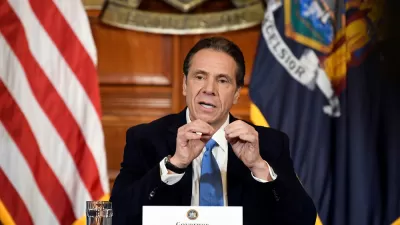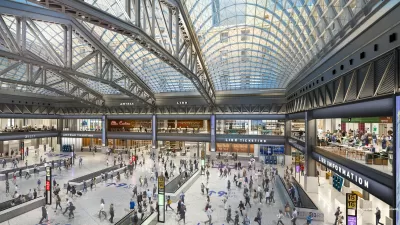An earlier post on New York Gov. Andrew Cuomo's big capital project proposal this week gave barely a mention of his new plans for the renovation, or rebirth, of Penn Station, America's busiest rail station.
The editorial board of The New York Times recaps part of the governor's busy week proposing new renovations to Penn Station, compared in the editorial to "a minimum-security prison that sells magazines and popcorn."
Between Proposal 5 (lower Thruway tolls!) and 7 (a bigger Javits Convention Center!), was one to make a New Yorker perk up: Proposal 6, transforming Penn Station.
The editorial indicates that developers had been selected to perform the transformation of Penn Station and Farley Post Office building into Moynihan Station and that while the first phase is underway, "the overall project has been stalled."
"It is unclear exactly how the more than $3 billion project, which the governor is calling the Empire Station Complex, will be paid for, but Mr. Cuomo is expected to unveil a financial plan for his transportation network at next week’s State of the State speech," wrote The New York Times' Emma G. Fitzsimmons and Charles V. Bagli on Wednesday.
The developers initially selected for the project ten years ago, Related Companies and Vornado Realty, "had agreed to pay the state more than $200 million for the Farley building and $110 million for development rights that they planned to transfer across Eighth Avenue for a residential tower," wrote Fitzsimmons and Bagli.
Should the two companies not be selected for Empire State Complex, "the state would be required to reimburse Vornado and Related for more than $30 million," according to Fitzsimmons and Bagli.
As in the first post on Gov. Cuomo's infrastructure agenda, the editorial board references New York's premier, though controversial builder: "Mr. Cuomo seems to have gone from zero to Robert Moses in 60 seconds."
FULL STORY: A New Old Plan for Penn Station

Study: Maui’s Plan to Convert Vacation Rentals to Long-Term Housing Could Cause Nearly $1 Billion Economic Loss
The plan would reduce visitor accommodation by 25,% resulting in 1,900 jobs lost.

North Texas Transit Leaders Tout Benefits of TOD for Growing Region
At a summit focused on transit-oriented development, policymakers discussed how North Texas’ expanded light rail system can serve as a tool for economic growth.

Why Should We Subsidize Public Transportation?
Many public transit agencies face financial stress due to rising costs, declining fare revenue, and declining subsidies. Transit advocates must provide a strong business case for increasing public transit funding.

How to Make US Trains Faster
Changes to boarding platforms and a switch to electric trains could improve U.S. passenger rail service without the added cost of high-speed rail.

Columbia’s Revitalized ‘Loop’ Is a Hub for Local Entrepreneurs
A focus on small businesses is helping a commercial corridor in Columbia, Missouri thrive.

Invasive Insect Threatens Minnesota’s Ash Forests
The Emerald Ash Borer is a rapidly spreading invasive pest threatening Minnesota’s ash trees, and homeowners are encouraged to plant diverse replacement species, avoid moving ash firewood, and monitor for signs of infestation.
Urban Design for Planners 1: Software Tools
This six-course series explores essential urban design concepts using open source software and equips planners with the tools they need to participate fully in the urban design process.
Planning for Universal Design
Learn the tools for implementing Universal Design in planning regulations.
City of Santa Clarita
Ascent Environmental
Institute for Housing and Urban Development Studies (IHS)
City of Grandview
Harvard GSD Executive Education
Toledo-Lucas County Plan Commissions
Salt Lake City
NYU Wagner Graduate School of Public Service




























